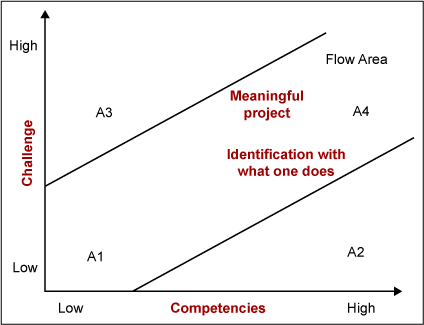
What separates high-performing Black Belts from low performers? Most people would probably automatically refer to project success: High-performing Black Belts better execute the Six Sigma methodology and deliver significant process improvements and accompanying financial benefits. While this answer is definitely true, it reflects a limited view. This article outlines a more comprehensive picture of Black Belt performance and its drivers.
A Definition of Performance
A fitting place to start is with a definition of what performance is. While there are many potential definitions out there, the following one looks at performance from an organizational context:
Performance is the value added to the organization that the person and/or the group can give with reference to the achievement of organizationally relevant objectives.
Following this definition, a specific Black Belt activity is not perceived as well performed by the quality of the execution of the tasks itself. The evaluation criterion is the degree to which this behavior contributes to the success of the company. This means, for example, that conducting a great data analysis during a Six Sigma project is only perceived as high performance behavior if the results of this analysis help achieve a project goal that at the same time contributes to the overall Six Sigma deployment objectives and the organization’s strategy.
This definition therefore includes the “what” and “how” of performance. What needs to be achieved refers to the company’s objectives. With regard to Six Sigma, these objectives are typically breakthrough process improvements and significant business benefits. A company should expect a Black Belt to close major competitive gaps by either enhancing the customer experience or generating positive economic profit. But also – in the longer term – cultural organizational change toward a data-driven decision-making process and customer-oriented organization can be achieved.
On the “how” side, performance-driving behaviors can be seen in four major areas:
- Task performance
- Leadership performance
- Interpersonal performance
- Ethical performance
Task Performance
Task performance refers to the technical project execution. This starts with selecting and scoping the right projects, ensuring Sponsor commitment and having sufficient resources available. During the project, high performance of tasks can be observed if the Black Belt selects the right tools from the Six Sigma toolbox to drive the right behavior during the project. In particular, tools that help to understand the root causes of the problem, statistical and process analysis tools to verify these causes, and techniques to generate and select the right solutions are key to project success.
During the Control part and the project follow-up phase, a successful Black Belt prepares and conducts a proper handover to the process owner and follows up on the implementation of solutions to ensure that KPIs and the business case are achieved and the process owner’s organization can easily implement and sustain the solution.
A company seeking successful Black Belts should look for a person with good analytical and project management skills. In terms of analytical skills, Black Belts should foster sound decision-making based on data. They ask the right questions and keep asking questions. Having an affinity for statistics is important here but not statistical expertise because running statistical analysis is rather easy today given good statistical data analysis software.
In terms of project management skills, Black Belts should already bring project management experience to successfully deploy tools required to plan and assign tasks and timelines, define roles and responsibilities, hold team members accountable, effectively run meetings, resolve issues, move projects forward and complete the projects in an appropriate timeframe with the expected benefits.
Leadership Performance
Successful Black Belts are results-oriented and strong in influencing people for results, developing team members, managing conflicts in the team and between other stakeholders, and leading change through strong listening, influencing and communication skills. High performers in the leadership category involve the key stakeholders early in the project and keep them up to date. They effectively communicate with the organization’s leaders, and they consistently motivate the team to high-performance levels.
But leadership performance relates not only to project leadership. A high-performing Black Belt also inspires people to apply Six Sigma tools in their day-to-day operations and drives enthusiasm for Six Sigma within the organization.
Interpersonal Performance
Interpersonal performance focuses on the behavior that a Black Belt shows in interaction with other people. One of the goals of a Six Sigma deployment is usually to build a strong Six Sigma community within the organization as a base for cultural change. Given that, a high-performing Black Belt will build networks with other people involved in the Six Sigma deployment and also with key decisions makers, process experts and other associates in the organization. Within this network the Black Belt will share best practices and drive best practice exchange between others. A high-performing Black Belt offers help to others where needed but is also open to receive help and coaching from colleagues.
Skills that are required here typically fall in the category of teamwork. These are skills such as listening and appreciating other people’s ideas, asking questions, encouraging people to participate and use effective communication channels between one another. The successful team player senses what contributions need to be made and how he or she can best support the group in achieving its goals.
Ethical Performance
During the last decade, stakeholders expect companies to commit more and more to their social and ethical responsibilities on top of their financial ones. This refers to company-internal behaviors like showing awareness of and commitment to company values and taking care of employee-related values as well as externally focused behaviors like starting a dialogue with important stakeholders (customers, business partners, community and environment) and engaging in social activities with specific stakeholder groups.
For a Black Belt, ethical performance can be observed on an individual, interpersonal and project level. On an individual level, a Black Belt accords to playing by the rules and values of the company and working with integrity. With regard to Six Sigma, this means not compromising on the philosophy and methods of Six Sigma by running every project under the umbrella of Six Sigma. Another ethical behavior is not trying to fulfill unrealistic expectations in Six Sigma projects like closure within two months or unrealistic goals. It can also mean that the Black Belt intervenes if he or she feels that Six Sigma is abused for political purposes (e.g., to give a rationalization program a nicer name).
On an interpersonal level, an ethically high-performing Black Belt ensures appropriately open and honest two-way communication with all internal and external stakeholders of the project, is transparent with regard to the project objectives, provides training as needed and gives recognition to associates.
Finally, on a project level, a Black Belt ensures that project objectives are also the supporting social responsibility and customer-satisfaction targets of a company. Projects are therefore selected that improve the safety and reliability of products or services, increase courteous attention to customer queries and complaints, ensure adequate supply of products or services, provide full and unambiguous information to potential customers as well as reduce the potential dangers of pollution or disposal of waste.
Going Beyond the Limits: Exceptional Performance
Sometimes being a good performer is simply not enough: What is required is outstanding performance or unprecedented results. This means outperforming ourselves and going beyond our own limits. For a Black Belt, this would imply leading extremely difficult projects and at the same time managing really well the political and organizational implications of the role.
The keys to exceptional performance for Black Belts are:
- Clear project objectives
- Ongoing feedback by sponsor and relevant stakeholders, including project team members
- Sense of ownership about the goals
- Sense of control over the performance drivers and the results
- Commitment and involvement
A clear leading indicator of outstanding performance in Black Belt projects is an impressive combination of focus, concentration and self efficacy that is called “flow.” To get to the flow area of performance, it is necessary for a Black Belt to lead a really challenging project but at the same time to be convinced to have the right competencies, as per the figure below (situation A4).

All other situations undermine exceptional performance and call for action by the Black Belt’s supervisor or coach (such as a Master Black Belt). Situation A3 is a threatening combination of high challenge and poor competencies, while A2 is the avenue of frustration, with high competencies wasted on a really simple challenge.
There is lot that can be done to raise the bar of Black Belt performance. First of all, clarify that performance is not just task related but also involves leadership, interpersonal and ethical performance. Second, lead them in the steady development of their limits, in order to create the flow experience.